| 1. |
Papi A, Brightling C, Pedersen SE, et al. Asthma. Lancet, 2018, 391(10122): 783-800.
|
| 2. |
Rees PJ. Guidelines for the management of asthma in adults. BMJ, 1990, 301(6755): 771-772.
|
| 3. |
中华医学会呼吸病学分会哮喘学组. 支气管哮喘患者自我管理中国专家共识. 中华结核和呼吸杂志, 2018, 41(3): 171-178.
|
| 4. |
Global Initiative for Asthma. Global strategy for asthma management and prevention: update 2006[EB/OL]. [2023-07-13]. http://www.ginaasthma.org/.
|
| 5. |
Global Initiative for Asthma. Global strategy for asthma management and prevention: update 2021[EB/OL]. [2023-07-13]. http://www.ginaasthma.org/.
|
| 6. |
Juniper EF, O'Byrne PM, Guyatt GH, et al. Development and validation of a questionnaire to measure asthma control. Eur Respir J, 1999, 14(4): 902-907.
|
| 7. |
Bateman ED, Boushey HA, Bousquet J, et al. Can guideline-defined asthma control be achieved? The Gaining Optimal Asthma ControL study. Am J Respir Crit Care Med, 2004, 170(8): 836-844.
|
| 8. |
Global Initiative for Asthma. Global strategy for asthma management and prevention: update 2014[EB/OL]. [2023-07-13]. http://www.ginaasthma.org/.
|
| 9. |
Wyrwich KW, Khan SA, Navaratnam P, et al. Validation and agreement across four versions of the asthma control questionnaire in patients with persistent asthma. Respir Med, 2011, 105(5): 698-712.
|
| 10. |
Korn S, Both J, Jung M, et al. Prospective evaluation of current asthma control using ACQ and ACT compared with GINA criteria. Ann Allergy Asthma Immunol, 2011, 107(6): 474-479.
|
| 11. |
Huang K, Yang T, Xu J, et al. China Pulmonary Health (CPH) Study Group. Prevalence, risk factors, and management of asthma in China: a national cross-sectional study. Lancet, 2019, 394(10196): 407-418.
|
| 12. |
Chen X, Sun W, Li S, et al. Current status of prevention and treatment of respiratory diseases in primary care in China: a cross-sectional study. BMC Pulm Med, 2022, 22(1): 156.
|
| 13. |
中华医学会呼吸病学分会哮喘学组. 支气管哮喘防治指南(2020年版). 中华结核和呼吸杂志, 2020, 43(12): 1023-1048.
|
| 14. |
中华医学会呼吸病学分会肺功能专业组. 肺功能检查指南(第二部分)--肺量计检查. 中华结核和呼吸杂志, 2014, 37(7): 481-486.
|
| 15. |
Juniper EF, O'Byrne PM, Roberts JN. Measuring asthma control in group studies: do we need airway calibre and rescue beta2-agonist use?. Respir Med, 2001, 95(5): 319-323.
|
| 16. |
Juniper EF, Svensson K, Mörk AC, et al. Measurement properties and interpretation of three shortened versions of the asthma control questionnaire. Respir Med, 2005, 99(5): 553-558.
|
| 17. |
彭博, 张小娟, 姜骁桐, 等. 基层医疗卫生机构慢性阻塞性肺疾病基本药物与诊断设备可获得性调查研究. 中国全科医学, 2022, 25(7): 771-781.
|
| 18. |
Juniper EF, Bousquet J, Abetz L, et al; GOAL Committee. Identifying 'well-controlled' and 'not well-controlled' asthma using the Asthma Control Questionnaire. Respir Med, 2006, 100(4): 616-621.
|
| 19. |
Sastre J, Olaguibel J, Vega JM, et al. Cut-off points for defining asthma control in three versions of the Asthma Control Questionnaire. J Asthma, 2010, 47(8): 865-870.
|




